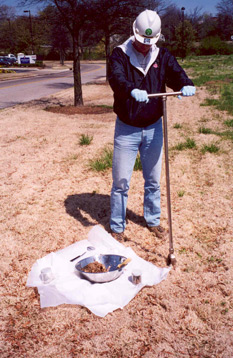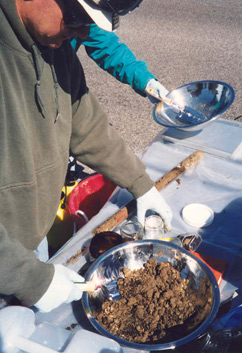Since 2001, Velsicol has spent nearly $1,000,000
to characterize the nature and extent of contamination along the
creek and to determine if any cleanup was necessary. The following
is a summary of the work that has been done so far.
2001
The 2001 study was designed to fill-in data gaps from previous
scientific studies and identify any areas of possible concern.
This study was the first to analyze overbank soils along a 2.5
mile length of the creek in the predominantly residential area
from Jackson Avenue, near the Velsicol manufacturing plant, to
Evergreen Street. In addition, scientists took more soil samples
than in any previous study and tested them for a broader range
of chemicals. Between March and May 2001, a total of 53 soil
samples were collected for analysis. Samples were also obtained
from the creek channel and banks and in the undeveloped storm
water storage areas in Sub-Area IV and Sub-Area V. Soil samples
taken by Velsicol were generally from the soils surface to a
12-inch depth. Holes were drilled in the concrete liner in order
to take samples in Sub-Area II.
An independent testing laboratory hired by Velsicol and the state's
environmental laboratory analyzed the soil samples for a wide range
of contaminants. All study data, including results from earlier
studies, were then compared to EPA Preliminary Remediation Goals
(PRGs), which are screening levels used to determine if additional
investigation is required.
All five Sub-Areas had one or more chemicals that exceeded the
screening levels, so all areas were carried into a more detailed
preliminary risk evaluation. Consistent with the outcome of all
studies since 1964, the 2001 study and preliminary risk evaluation
did not indicate any imminent risk to public health.
2002
In 2002, Velsicol focused its efforts on investigating the Cypress
Middle School and University Park area, located in Sub-Area III.
Scientists collected 30 samples and evaluated the contents. Toxicologists
found no unacceptable imminent or long-term human health risks. "In
an abundance of caution," TDEC elected to install a layer
of clean soil over areas that had elevated contaminant levels.
State officials also required posting of warning signs around
Sub-Areas IV and V as a precautionary measure until the investigations
are completed.
2003
In 2003, Velsicol worked closely with TDEC and EPA to sample 84
properties along the creek. They represent about half of the
properties in Sub-Area III. The samples were tested by approved
laboratories. TDEC set a screening level of 0.7 parts per million
of dieldrin, the main compound screened for that could potentially
impact health. For most properties, only very low levels of contamination
were found. In one-third of the cases, however, dieldrin was
found in the soil above the state's screening level. This meant
more testing was necessary to investigate soils at properties
located adjacent to those with "elevated" contaminant
levels. In March 2004, test results for individual properties
were reported to landowners/residents.
2004
Fifty additional properties were sampled, including properties
adjacent to those above the screening level. At this point, 76
percent of the properties that back up to the creek have been
sampled. Laboratory analyses were completed in November. Scientists
and the U.S. EPA are reviewing the data to assure quality and
accuracy for use in the risk assessment. In December 2004, test
results for individual properties were reported to landowners/residents.
Velsicol also supported TDEC and EPA in testing soils in Sub-Area
IV during June and July. This work included the collection of soil
samples from 130 locations on a 100-foot grid. TDEC and EPA evaluated
the test results and identified areas for additional soil sampling
and testing.
2005
As follow-up to the 2004 Sub-Area IV soil investigation, 48 additional
soil samples were collected for testing during April 2005. Velsicol
again supported TDEC and EPA’s work by way of mapping and
sample collection. TDEC and EPA are evaluating these Sub-Area
IV test results, with support from Velsicol. During August 2005,
Velsicol collected and tested soil samples from six additional
residential properties in Sub-Area III. The focus of this investigation
was properties adjacent to previously tested properties where
the dieldrin concentrations were found to be above three parts
per million. The objective of this investigation was to determine
if any properties adjacent to those where TDEC had directed Velsicol
to perform soil removal based on an action level of three parts
per million, would also warrant cleanup. |

